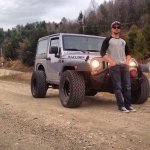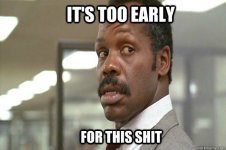Here is the skinny on the stabilizer posts I see from an engineering aspect.
A steering stabilizer go's allot deeper then trying to cure issues. A steering stabilizer (like any dampener) is added to a design to move or attenuate the natural frequency of the assembly. The designers goal is to prevent vibration amplitudes that cause damage.
All steering systems (solid axle or IFS) have a natural frequency where they will vibrate, shimmy, wobble, or have a tendency to become uncontrollable. This is due to the fact they are attached to rotating parts (wheels) and are allowed to rotate themselves (steer). They vibrate, have movement, and move at velocities that can place the assembly (or critical parts) in a resonant frequency.
All assemblies in nature have a natural frequency, it's just that most do not move fast or slow enough to cause a problem. Manmade assemblies also have natural frequencies that have motivated major design advancements and understanding of the issue (like the Tacoma Narrows Bridge disaster).
A designer tries to design around the natural frequency so that it will not be a problem. This is accomplished a number of ways:
1. Make the frequency low enough, so that the assembly is accelerated through the critical (natural) frequency fast enough that it will not produce amplitudes high enough to cause damage. Adding mass will lower the natural frequency. Motors, turbines, and blower assemblies are designed this way. The natural frequency is usually below 30% of the operating speed and the assembly never operates anywhere near this speed. If you find a problem add flywheel weight.
2. Make the assembly light enough that it's mass and amplitude has little impact on the total assembly. This is common on a lightweight rear view mirror on a motorcycle. All riders know the speed where fuzzy mirrors become a problem and avoid that speed. The mirror mass is so low that it does not impact the rest of the bike. On a car we just add mass to a mirror and move the critical frequency lower knowing that the potential for a problem is minimal because it is not connected to the steering. Imagine what steering the same bike would be like if we raised the mirror mass and was great enough to produce headshake?
3. Make the natural frequency high enough that we do not operate the assembly anywhere near enough to cause damage. Reducing mass increases the natural frequency. I have been told that the Jeep 4.0 has a critical frequency around 6000 rpm that will cause oiling problems, due to bearing clearance irregularities caused by the crankshaft flexing. When the engineers redesigned the crankshaft, from twelve counterweights to four, they limited the performance below the critical speed. A sailor will feel (and hear) when the boat is reaching the critical hull speed. The shrouds and entire boat will start to hum, warning a change in trim or tack is in order (slow the boat).
4. Make the assembly tough enough to handle the critical speed without major damage. This appears the method employed by Jeep on the original twelve counterweigh crankshaft. The critical frequency is still there, but the crankshaft is designed to accept the added stress. If someone does the research on the bridge failure mentioned above, they will find that all suspension bridge designed were revised for improved deck strength and aerodynamic dampening to accomplish the same effect.
5. Dampen the assembly so that it never remains at any one speed long enough to create large amplitudes. This is the utility of velocity dampeners (shocks) because the resistance is always changing with amplitude and velocity. A critical amplitude and speed can be targeted and a shock designed to reduce the speed out of the range of the critical frequency. Before shocks, designers used caster and the resulting friction drag on the tire to produce dampening.
Where does this fit into the stabilizer?
First realize the system (suspension) has a natural frequency. It is not a design flaw. It is something that is NOT easily designed out of the system.
The result is designers combine all the tricks to reduce the chance a natural frequency will become a problem: caster, camber, scrub radius, tire mass, wheel offset, suspension bushing stiffness, linkage design, control or a-arm mass, driveline angle, shock valving, and a stabilizer. Each of these tricks adds dampening to one or more components. The goal is to assure that two or more components will not work in resonance at the same speed.
Are all of the tricks needed? Probably not, but if an Attorney pointed out that you failed to exhaust all potential problems and solutions you could find yourself wishing you added more caster (demanding power steering), more tire pressure (requiring softer springs), a stabilizer (resulting in slower steering), and an anti-sway bar (harsher ride) to avoid a lawsuit.
People wonder why modern 2000 lb. cars need power steering when it was rare on 4000 lb cars of 50 years ago, and they had easier steering? Well, dampening added by all the tricks has to be countered with more power steering.
Designs are driven to reduce weight to achieve better mileage and performance. You cannot just add mass and make everything so damn large and expensive that it cannot be afforded. Even if we did get extreme on the design there are ten "idiots" unknowingly waiting to prove the "idiot proof" design fails to deliver.
Considering that thousands of Jeeps have been sold with a 100,000 mile life is common for the design, the few wobble problems that do exist reflect a good solution in using a stabilizer. Unfortunately something as simple as a weak bushing can upset the design when added stress is placed on the system (big tires, wear, bad alignment). All the bushing and sleeves can be tight and even a loose shock or weak rubber in a control arm bushing can promote the wobble.
A special steering system (even as advanced as IFS) will not eliminate wear due to vibration. Every time I read a post that this or that custom part "got rid of my Death Wobble," I reframe from the urge to say bull shit. I hold my thoughts only because the solutions, while not addressing wobble, have other benefits. The many "solutions" that only postponed the replacement of other bushings, after more wobble blues, proves this out.
I believe that an owner can remove a stabilizer and not experience wobble. It will still be safe, for that owner that has a high level of attention to detail and uses it every time they get ready to drive it (pre-flight).
Will removing the stabilizer work for you? Maybe, but I'll gamble it will not eliminate an existing wobble condition and I'll give odds it's removal will make the wobble worse.
Is it a safe practice to drive without a stabilizer? Probably not.
Attention to detail (maintenance and proactive part replacement) can reduce the chance you will experience any wobble due to vibration. I believe this is the best solution.
Is a dual system needed?, no, it's not but running a pressurized damper will require an opposing damper. Also adding a ram assist system while helping turn those big tires will also have the benefit of reducing vibration resonance.
So in knowing that all the parts that make up our axle assemblies, tires/wheels, steering and adding mass. I would recommend that a damper (steering stabilizer) be used to dampen what it's suppose to, vibration resonance.





